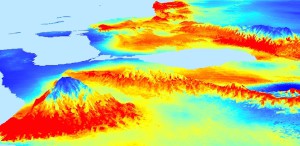SDM model for the Caribbean spiny pocket mouse
Source: Radosavljevic, A. and R. P. Anderson. 2014. J. Biogeogr 41:629-643
We are organising the 4th edition of the course “Species distributions models: concepts, methods, applications, and challenges”, which introduces the fundamental concepts underpinning ecological niche models (ENM), describing some of the most prominent methods currently in use, and discussing the strengths and limitations of these models for different applications. The course gives equal weight to theory and application. The students will have the opportunity to learn how to run ENM with the new SDM R platform (Naimi & Araújo 2016 Ecography) and they will be asked to bring their own data (if such data are not available we can provide our own data). During one day the students will analyse their data and prepare a small report for discussion in the class. The proposed course is the fourth after a first edition conducted at the Imperial College London (2014) and a second and third editions at University of Évora (2015, 2016). It also builds on slightly shorter courses developed by Miguel Araújo at the University of Copenhagen and the Estación Biologica de Doñana (CSIC).
Course Directors
Professor Miguel Araújo
Dr. Babak Naimi
Course Objectives
In the end of the course, the students will be equipped to:
1. Understand the theoretical underpinnings of ecological niche models
2. Understand the strengths and limitations of ecological niche models in the context of different uses
3. Correctly design an ecological niche modelling study for a variety of uses
4. Get started with ecological niche modelling using SDM R.
Dates and logistics
The course will take place in the historical city of Évora, in Portugal, between the 22th and the 28th of May 2017.
Course length and ECTS
The course includes 56 hours on-site, including breaks. The course is equivalent to 5,6 ECTS (European Credit Transfer System), assuming the rule of 10:1, which means that 1 course lesson (=1 hour) gives 0.1 ECTS credits, taking a preparation factor of 1.5. Participants who have completed the course will receive a certificate of participation at the end of it.
Requirements
Some experience in the computer language R is desirable, and experience with GIS is helpful. All participants must bring their own personal laptop.
Language
English.
Registration
Registrations are opened here until the 21st of April 2017.

Hello,
Any perspective for a new course in SDM/ENM techniques in 2017? How about 2018?
congratulations for the amazing job you do in your lab!
Many thanks in advance
Cassiano
Yes, a new one happening in November 2018. Check the web page!!
Hello,dear
I would like to participate SDM course. but it was finished. I am very interested in learning SDM.
my country (Iran) , so inform and know of the time of course and participate are difficult.
but i like to learn it , if is it possible could you guide me
best regards
where can I buy the course video?
Thanks for the query. We don’t have videos of the courses but you are welcomed to apply for physical participation in it. We have a 2018 edition coming up in November.